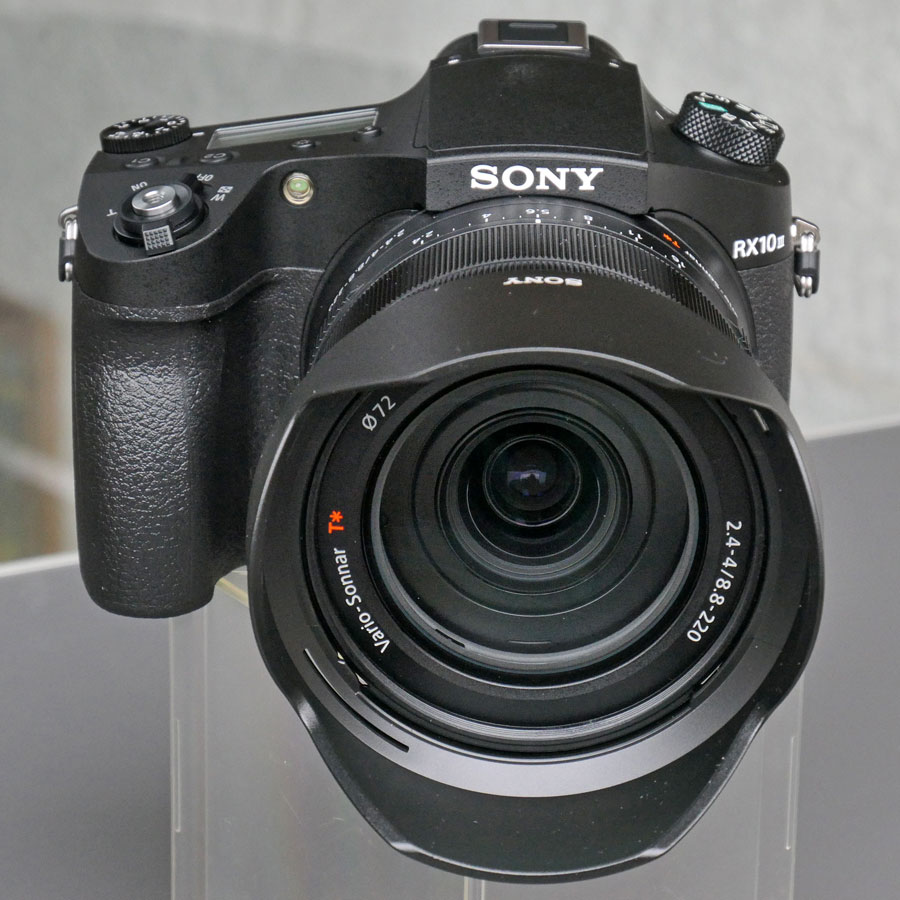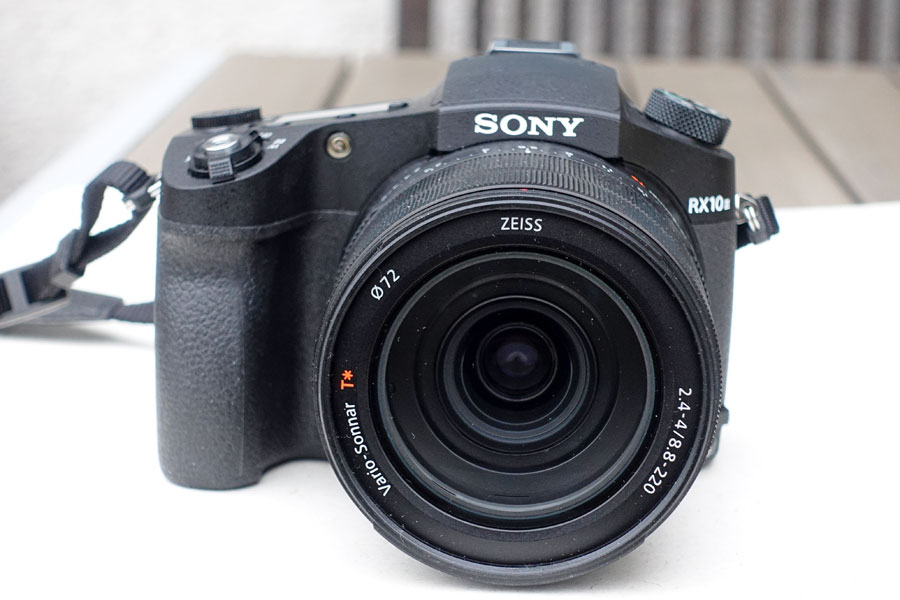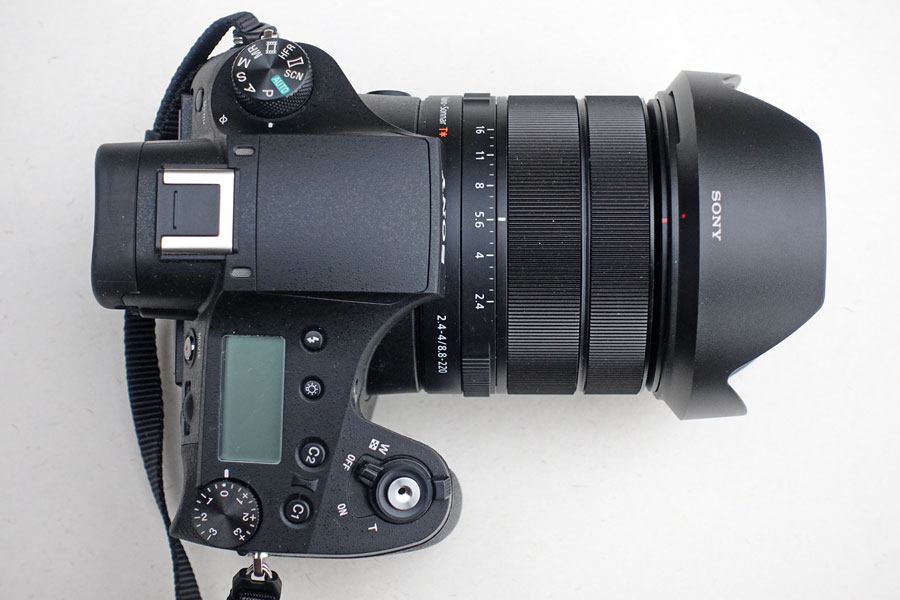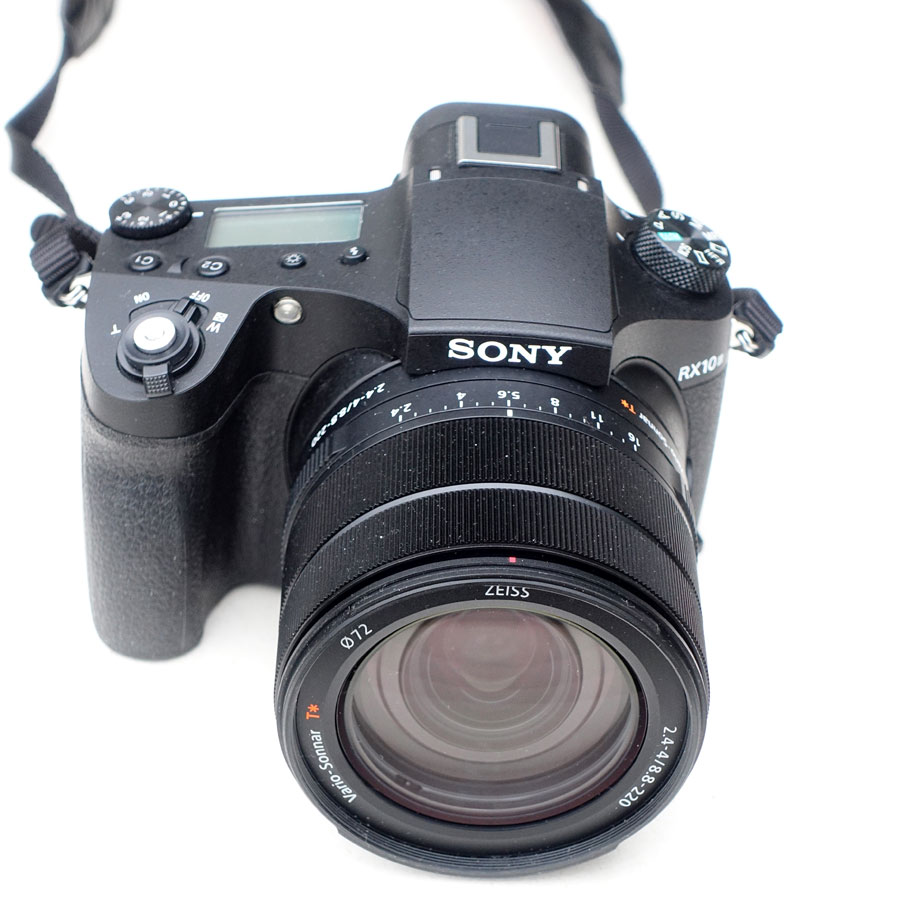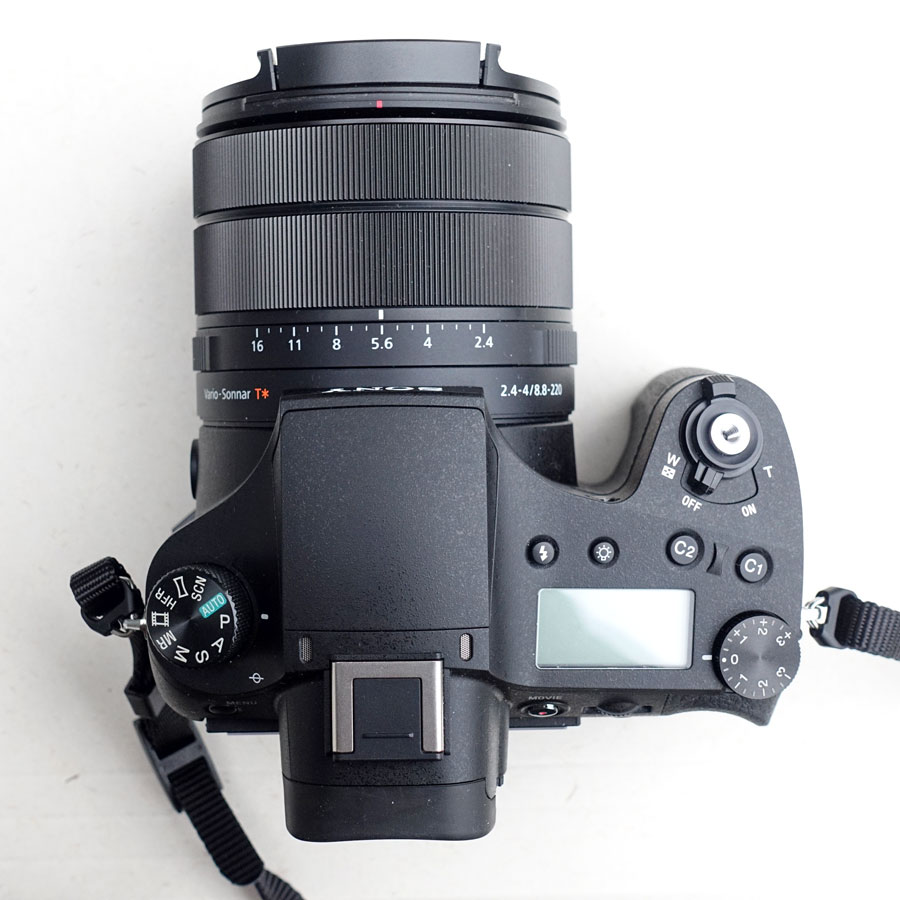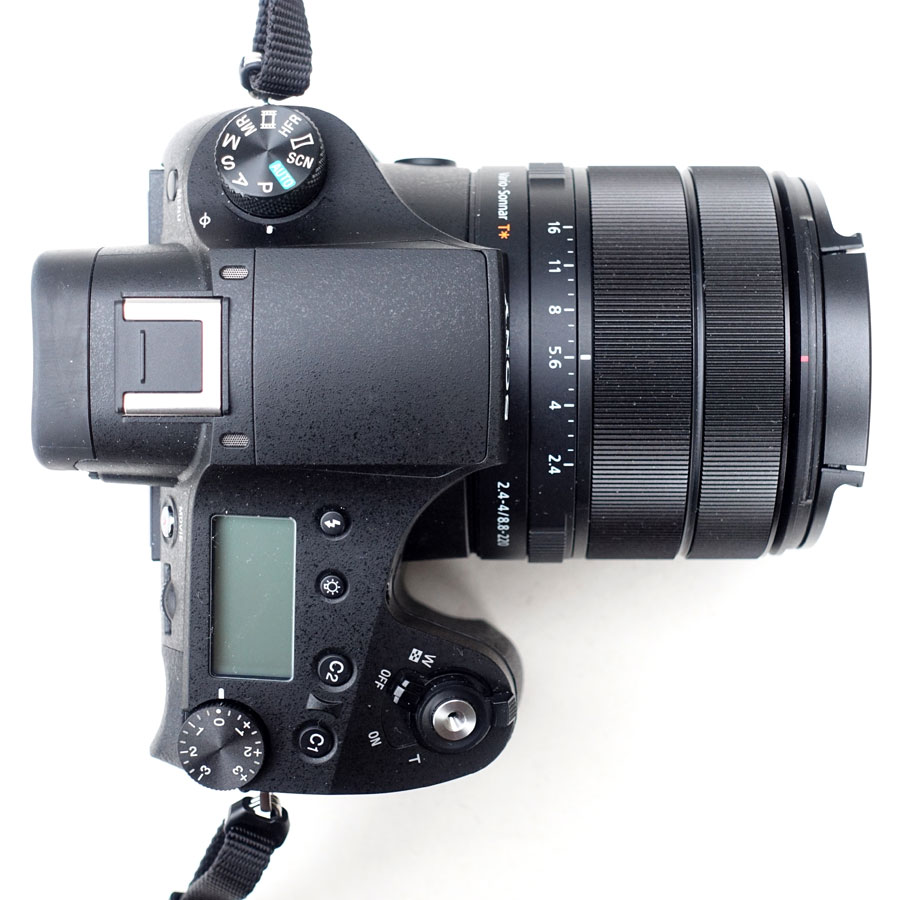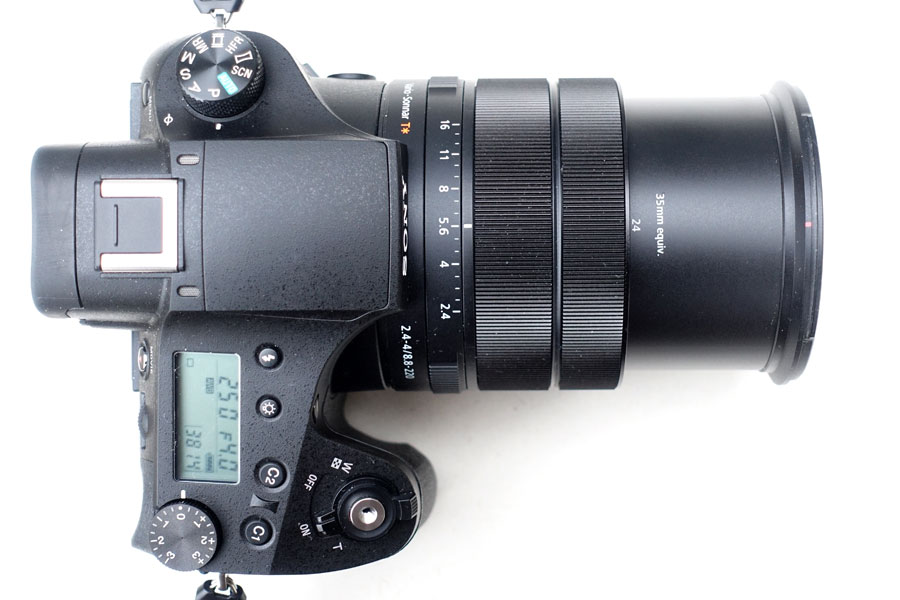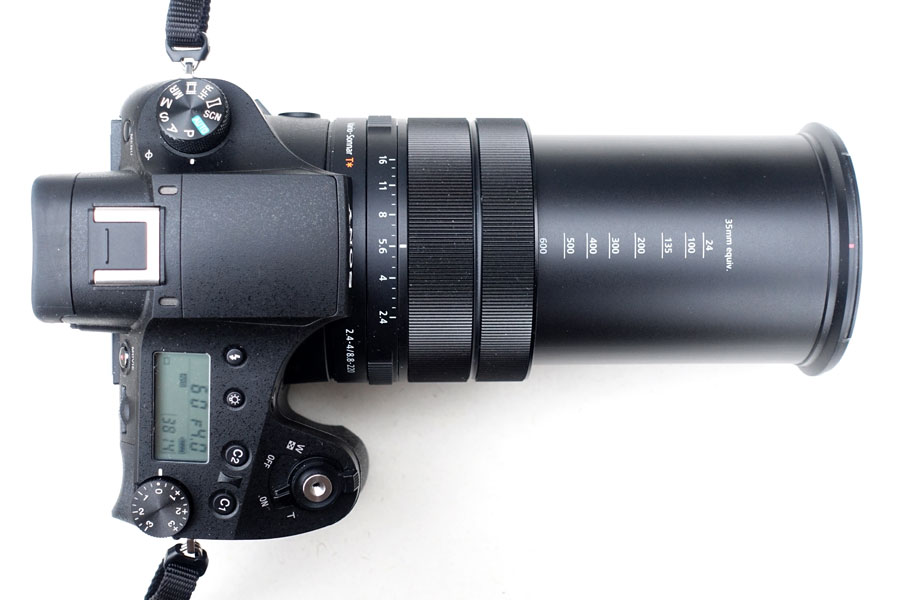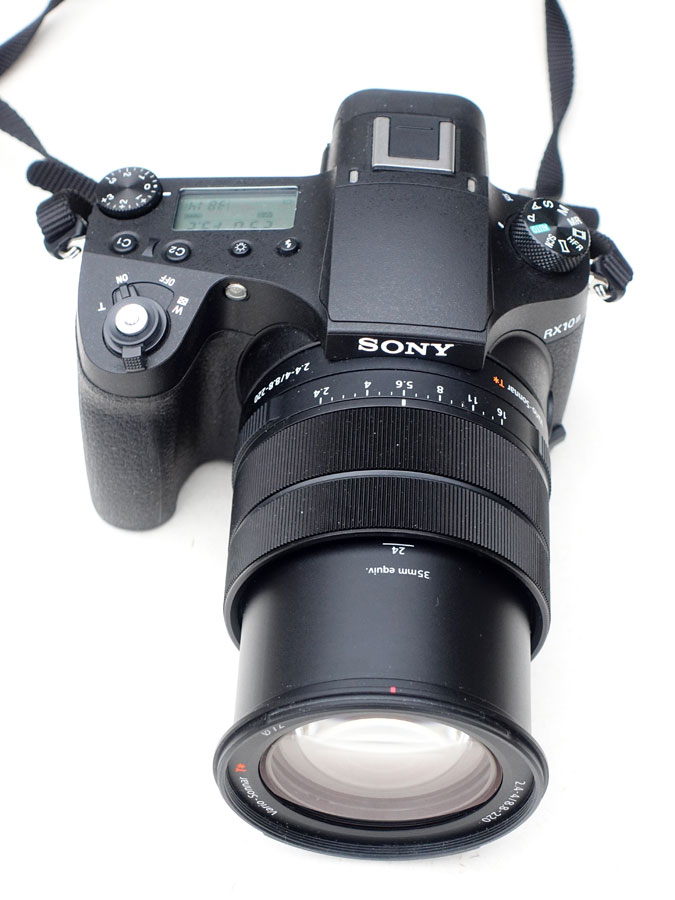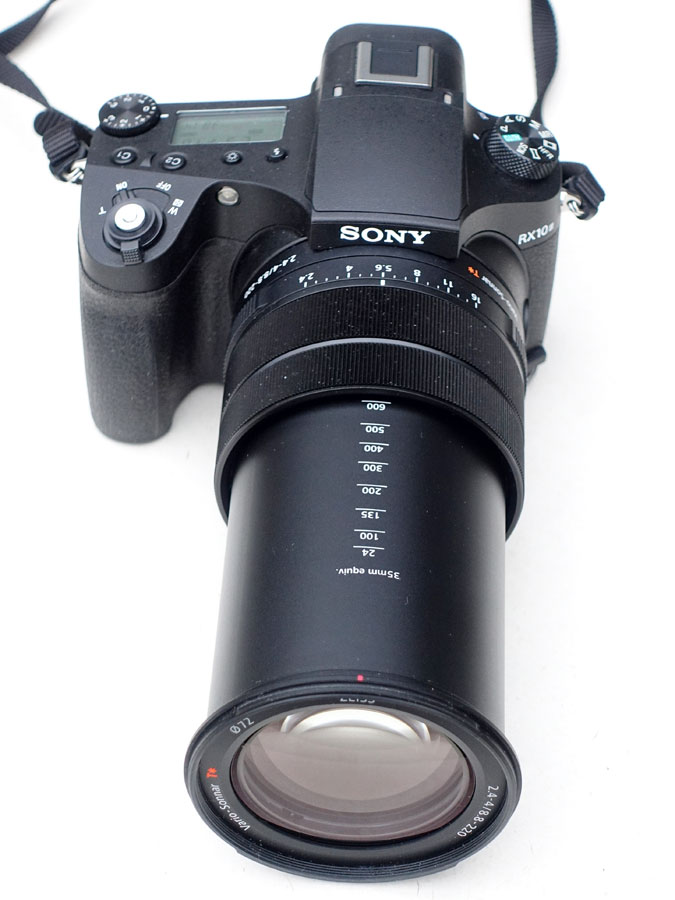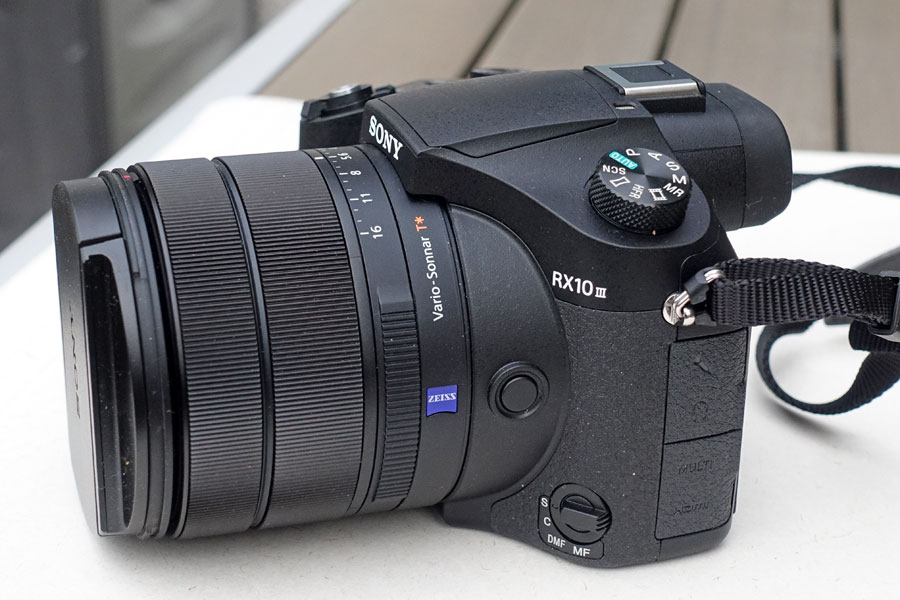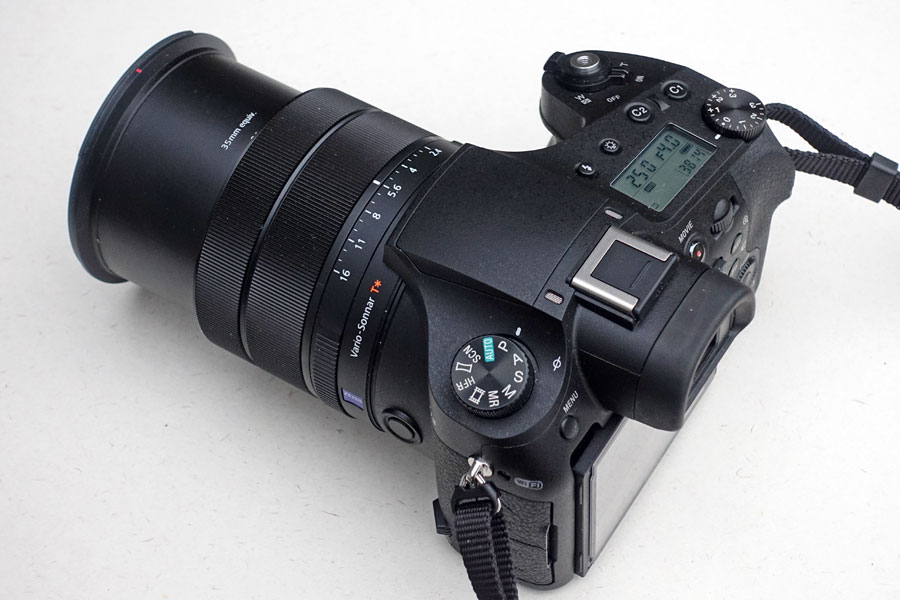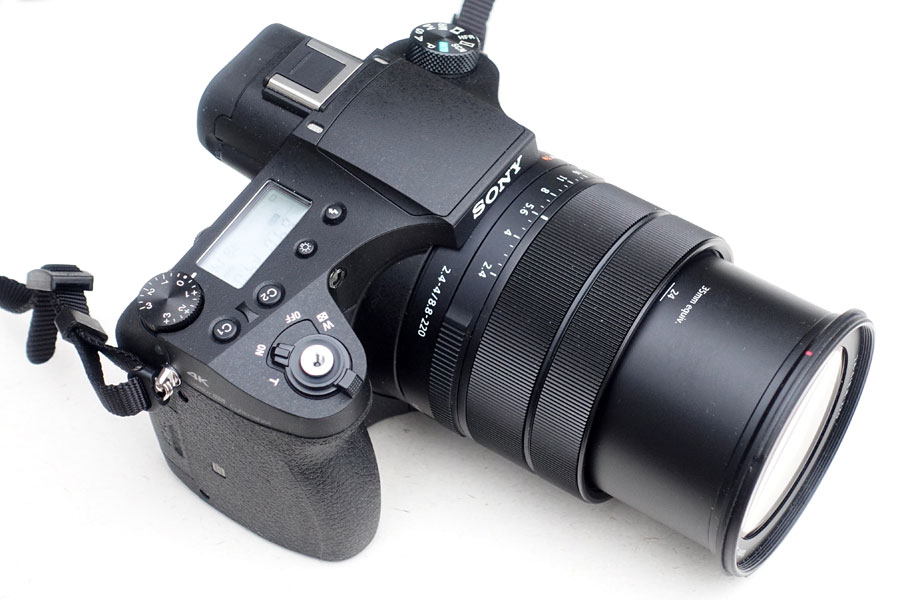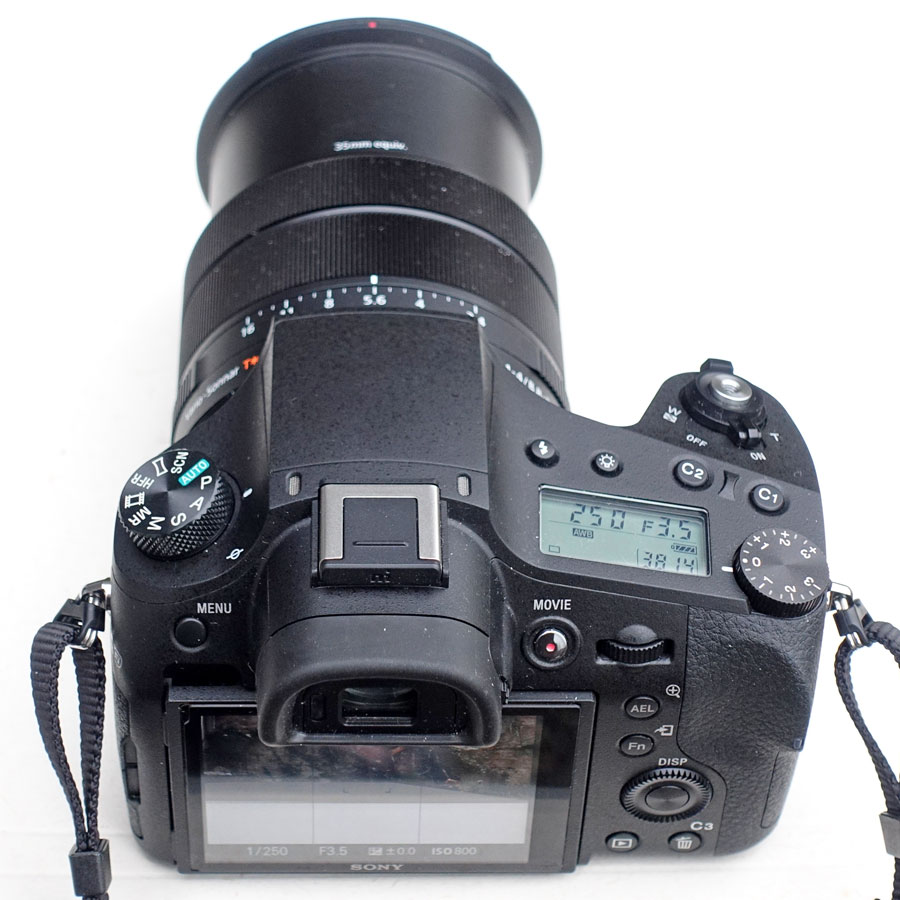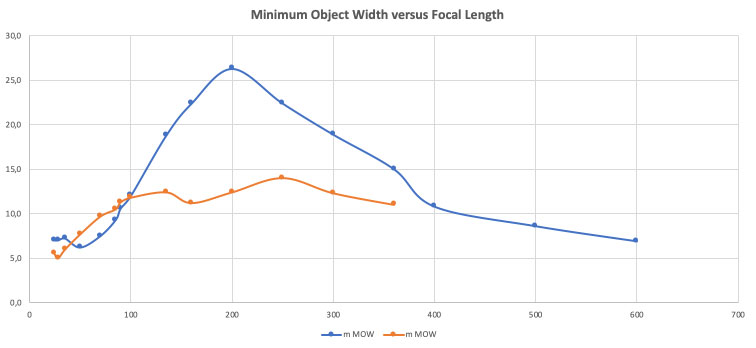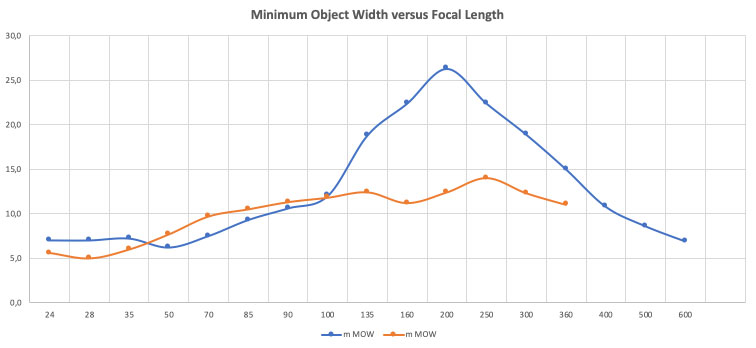Sony RX10 M3: Lens
Lens Characteristics in Short | A Few Technical Data | Some Quotations from Lens Reviews | My Own Two Cents... | References
On this page, I would like to discuss one the specific characteristics that lead me to buy the Sony RX10 M3, namely the lens. I investigate what the available test results and the reviewers say, and I also offer links to camera reviews.
Note: Since the lens on the Sony RX10 M4, which I bought as a replacement for my Sony RX10 M3, is identical to the one on the M3, this page is also valid for the Sony RX10 M4.
Lens Characteristics in Short
The Sony RX10 M3/4 features a fixed Carl Zeiss® Vario-Sonnar T* 8.8-220mm (24-600 mm equiv.) f/2.4- f/4.0 lens with a zoom range of 25 x (18 elements in 13 groups, including 6 aspheric lenses). Thus, it offers the equivalence of numerous "classic" prime lenses between 24 mm and 600 mm. Zoom is set using the zoom lever or using the zoom ring at the lens (this is configurable). Manual distance is set using the focus ring. There are marks for the equivalnt focal length on the lens, and the camera regrettably lacks distance and depth of field indicators on the LCD screen (only a coarse distance scale is shown when focusing manually).
Photos of the Lens (RX10 M3)
The lens does have a 72 mm filter thread for attaching filters or close-up lenses, which is rather large. Of course, I do not have filters, lenses, or adapters with with diameter...
Find more technical information about the lens below.
In-Camera Correction of Lens Deficits
All lens designs are a compromise between different requirements and therefore have certain deficits - the Sony RX10 M3/4's lens is no exception to this rule. Therefore, the lens's deficits are corrected in software for JPG images, but not for RAW images (ARW format).
A Few Technical Data
| Data | Sony RX10 M3/4 | Comment |
| Lens | Carl Zeiss® Vario-Sonnar T* 8.8-220 mm (24-600 mm equiv.) f/2.4-f/4 |
The same lens is used in the RX10 model 4. |
| Zoom | Optical Zoom: 25 x Clear (Image) Zoom: 20 MP approx. 50 x / 10 MP approx. 70 x / 5 MP approx. 100 x / VGA approx. 380 x Digital Zoom: up to 100 x |
There are two types of digital zoom: Clear (Image) Zoom (higher quality, lower range), and Digital Zoom (lower quality, wider range) |
| Filter diameter | 72 mm | |
| Aperture range | From 2.4 to 16 in 1/3 EV increments | Maximum aperture depends on focal length. |
| Distance setting range (from front lens) | AF (W: Approx. 3 cm to infinity, T: Approx. 72 cm (28.35") to infinity; at fl = 250 mm (equiv.): 140 cm (55.12") to infinity | Distances are measured from the lens (as advertised by Sony); the camera
provides larger values (measured from the focal plane). Macro is practically usable only at the wide end (up to 50 mm) and at the long end (500-600 mm). |
| Smallest object field | Approx. 72 x 48 millimeters at wide angle and long end (my own measurement) > 0.18 = 1:5.5 | Magnification: 1:5.5 (without close-up lens) |
Maximum Aperture Versus Focal Length
This is what I found out:
Focal Length (mm) |
|||||||||||||
Equivalent |
24 | 28 | 35 | 50 | 70 | 85 | 100 | 135 | 200 | 300 | 400 | 500 | 600 |
| Actual* | 8 | 10 | 12 | 18 | 25 | 31 | 36 | 49 | 73 | 110 | 146 | 183 | 220 |
Maximum f-stop* |
2.4 | 2.8 | 3.2 | 3.2 | 3.5 | 3.5 | 4.0 | 4.0 | 4.0 | 4.0 | 4.0 | 4.0 | 4.0 |
*) As indicated by the camera
Smallest Object Field (Minimum Object Width)
These are my own coarse measurements on this topic:
| Focal Length (equiv.) |
Distance from Sensor Plane* |
MF | AF (DMF) | Max. Aperture |
| mm equiv. | cm | cm | cm | f |
| 24 | 18 | 6.8-6.9 | 7.1-7.2 | 2.4 |
| 28 | 18 | 6.9-7.1 | 6.6-7.1 | 2.8 |
| 35 | 18 | 6.8 | 7.0-7.4 | 3.2 |
| 50 | 18 | 6.2-6.3 | 6.1-6.3 | 3.2 |
| 70 | 22 | 7.6 | 7.3 | 3.5 |
| 85 | 28 | 9.2 | 9.5 | 3.5 |
| 100 | 36 | 11.4 | 11.4-12.7 | 4.0 |
| 135 | 69 | 18.9 | 18.8 | 4.0 |
| 200 | 140 | 26.6 | 26.0-26.6 | 4.0 |
| 300 | 150 | 18.9 | 18.9 | 4.0 |
| 400 | 110 | 10.8 | 10.7 | 4.0 |
| 500 | 96 | 8.6 | 8.6 | 4.0 |
| 600 | 92 | 6.9 | 6.8 | 4.0 |
*) According to camera; note that the distance from the front of the lens body (not the lens) is much shorter (the distance between the focal place and the front of the lens body differs depending on the focal length).
These are just coarse numbers, because I did not do "controlled" tests, and it was sometimes difficult to perform the test. So there are variations in the numbers, but I think that the overall performance can be extracted from these numbers.
On another page, I consolidated these numbers a little bit and added Panasonic TZ202 data to be able to create diagrams from them and to compare the close-up behaviors of both cameras. Both diagrams show my mean minimum object width values across the focal length scale.
Do not take all this too seriously, but a few things can be easily read from these diagrams and the tables above. Here, I comment only on the RX10 M3/4:
- There does not seem to be much difference in the camera's macro performance between 24 mm and 50 mm (equiv.)*, and up to 70 mm, there is little deteriotation.
- Above 70 mm things change dramatically, and between 135 mm and a little less than 400 mm, the macro performance of the RX10 M3/4 is less impressive, to say the least.
- The performance improves again, however, between 400 mm and 600 mm, and at 600 mm, it is once again at the level of the wide end of the lens, which I find quite remarkable.
A few more remarks:
- The RX10 M3/4 lens has its "sweet spots" for close-up shots at
50 mm and 600 mm.
Thus, I can confirm Ken Rockwells suggestion to shoot close-ups either at a focal length of 50 mm or 600 mm (equiv.) if magnification is important for you. - The close-up behavior of the Sony RX10 M3/4 between the focal lengths of 100 to nearly 400 mm is odd to say the least. It seems to reflect the complexity of the lens. Usually, it is not a problem to magnify less, but for interior shots, the magnification at 400 mm may be too much at 1 m distance while you cannot step back to use a minimum distance between 1.2 m and 1.5 m as is required for focal lengths between 200 mm and a little less than 400 mm. Perhaps focal lengths between less than 160 mm and 70 mm to 85 mm can help you out here and close the gap...
- The smallest minimum object width that the RX10 M3/4 can achieve is a little
more than 6 cm at 50 mm; above 400 mm, the minimum object width decreases
from nearly 11 cm to nearly 7 cm. Thus, beginning with 400 mm and beyond,
the RX10 M3 really shines.
With a minimum object width of about 7 cm at 24 mm and 600 mm and of 6.2 mm at 50 mm (equiv.), the RX10 M3/4's macro performance is not outstanding, but very acceptable. Using Clear Image Zoom, it can be improved at the long end to about 36 mm, that is, to what we would call a 1:1 magnification ratio for full-frame cameras.
Close-Up Samples - "Sweet Spots"
The following close-up samples taken with the Sony RX10 M3 demonstrate the "sweet spots" of the lens for taking optimal close-ups (the maximum width of the butterfly Hamadryas belladonna is about 6.8 cm):
 |
 |
|
50 mm (6.1-6.3 cm) |
85 mm (9.2-9.5 cm) |
|
 |
 |
|
400 mm (10.7-10.8 cm; approx. 90 cm from lens) |
600 mm (6.8-6.9 cm; approx. 75 cm from lens) |
|
 |
 |
|
1200 mm, Clear Image Zoom (digital zoom; 3.5 cm; approx. 72 cm from lens) |
Ditto, for comparison purposes |
Sharpness Data
See the Lens Reviews below.
Lens Reviews and some Quotations from Reviews (M3)
In the following, I cite a few sections about the lens of the Sony RX10 M3 from reviews that I found on the Internet. This selection is, of course arbitrary, but may help readers gain a certain "feeling" for the lens.
dpreview.com
In the review of the Sony RX10 M3 on dpreview.com, the authors summarized the following about the lens:
- The superb quality of the RX10 III's lens is quite a technical achievement, to say nothing of the overall feature set Sony has included as well. Whether you're zoomed in or zoomed out, focused close or focused on infinity, you'll be impressed with the sharpness offered by this 24-600mm equivalent F2.4-4 zoom lens.
- ... we've all been impressed with the quality of the RX10 III's lens. It's sharp throughout the range, and offers pleasing background blur at longer focal lengths and shorter subject distances.
For details of the lens' performance at various ISO values and in comparison to other cameras, you can have a look at the studio scene on the same page.
digitalkamera.de (Free and Pay Content)
The German photography Website digitalkamera.de published a test of the Sony RX10 M3 (in German, performed with DxOMark software). Here is an excerpt of the result for the lens (too long for translation...):
- Das Objektiv schrammt mit dem 20-Megapixel-Sensor nur ganz knapp unterhalb der Marke von 60 Linienpaaren pro Millimeter (lp/mm) im Kleinbildäquivalent bei 50 Prozent Kontrast vorbei. Erreicht wird die höchste Auflösung im Weitwinkel in der Bildmitte bei F2,8 und F4. Bei F5,6 beginnt bereits die Beugung einzusetzen, die aber erst bei F11 und erst recht bei F16 die Auflösung deutlich verringert. Am Bildrand liegt die Auflösung im Weitwinkel knapp 30 Prozent unter der im Bildzentrum. Das ist ein durchaus sichtbarer Randverlust, zumindest bei größeren Ausgabeformaten, aber noch nicht dramatisch. Von F2,4 bis F8 werden jedenfalls locker über 40 lp/mm am Bildrand aufgelöst. Zoomt man das Objektiv, so verringert sich die Auflösung stetig. Bei 120 Millimeter entsprechend Kleinbild werden nur noch knapp über 50 lp/mm erreicht – dafür aber sowohl im Bildzentrum als auch am Bildrand. Die Auflösung ist außergewöhnlich gleichmäßig. Bei langer Brennweite schließlich gibt es wieder einen Randabfall der Auflösung, doch selbst im Bildzentrum sind die 50 lp/mm allenfalls ein feuchter Traum. Nur bei F4 und F5,6 gibt es überhaupt über 40 lp/mm, am Bildrand muss man sich gar mit maximal 36 lp/mm begnügen. Nichtsdestotrotz ist auch eine solche eher mäßige Auflösung einem Digitalzoom klar überlegen.
- Die Verzeichnung sowie die Randabdunklung des Objektivs sind völlig unkritisch. Eine Verzeichnung gibt es schlicht nicht, die Randabdunklung ist minimal. Bei den Farbsäumen wiederum sieht es schon etwas anders aus. Im Mittel fallen sie zwar gering aus, im Weitwinkel werden die Extreme in der Nähe der Bildränder jedoch leicht sichtbar, in Telestellung etwas stärker. Die mittlere Brennweite schlägt sich hierbei mit den geringsten Farbsäumen am besten.
The lp/mm values have been scaled to 35 mm values, but I do not quite understand what this means.
They also published a thorough technical lab test of the Panasonic TZ202 (in German), which can be downloaded for a fee from this page. Since this is pay content, I cannot report on this test here.
CHIP
Excerpts from Sony Cyber-shot DSC-RX10 III (Digitalkamera) - Bridge-Kamera der Luxus-Klasse (Moritz Wanke, Chip):
- ... the image quality of the 1-inch sensor with 20 megapixels can easily compete with high-quality system cameras. The Sony RX10 III delivers just over 1,700 line pairs per image height at ISO min in the image center. The usual drop in edge sharpness for bridge cameras remains within the green range with around 15 percent. On the other hand, the loss of sharpness at full telephoto of approximately 32 percent is more noticeable. (... die Bildqualität des 1-Zoll-Sensors mit 20 Megapixel kann mit hochwertigen Systemkameras locker mithalten. Knapp über 1.700 Linienpaare pro Bildhöhe serviert die Sony RX10 III bei ISO min im Bildzentrum. Der für Bridge-Kameras sonst übliche Randschärfeabfall bleibt hier mit rund 15 Prozent im grünen Bereich. Dagegen fällt der Schärfeverlust im vollen Tele von circa 32 Prozent merklicher ins Gewicht.)
- Resolution at ISO min: 1.599 line pairs
Resolution at ISO 400: 1.566 line pairs
Resolution at ISO 800: 1.496 line pairs
My Own Two Cents...
It is still too early to state any opinions here...
References
The following online reviews of the Sony RX10 M3 typically include a review of the lens:
- Review of Sony RX10 M3 on dpreview.com: www.dpreview.com/products/sony/compacts/sony_dscrx10iii
- Review of Sony RX10 on dpreview.com: www.dpreview.com/reviews/sony-cybershot-dsc-rx10
- Review of Sony RX10 M2 on dpreview.com: www.dpreview.com/reviews/sony-cybershot-dsc-rx10-ii-in-depth-camera-review
- Review of Sony RX10 M4 on dpreview.com: www.dpreview.com/products/sony/compacts/sony_dscrx10iv
- Review of the Sony RX10 Mk III (Ken Rockwell): kenrockwell.com/sony/rx10-iii.htm
- Sony RX10 III: The Swiss Army Knife of Cameras (Craig Litten on Steve Huff's Site): www.stevehuffphoto.com/2016/08/05/sony-rx10-iii-the-swiss-army-knife-of-cameras-by-craig-litten
Reviews in German
- Sony Cyber-shot DSC-RX10 III (Digitalkamera) - Bridge-Kamera der Luxus-Klasse (Moritz Wanke, Chip): www.chip.de/test/Sony-Cyber-shot-DSC-RX10-III-Digitalkamera-Test_139934527.html
- Die Ergebnisse aus unserem Sony RX10 III Lesertest - Testurteile aus Lesersicht (fotomagazin.de): www.fotomagazin.de/technik/tests/die-ergebnisse-aus-unserem-sony-rx10-iii-lesertest
- Testbericht Sony Cyber-Shot DSC RX10 III (dkamera.de): www.dkamera.de/testbericht/sony-cyber-shot-dsc-rx10-iii/
- Testbericht: Sony Cyber-shot DSC-RX10 III (Benjamin Kirchheim, digitalkamera.de): www.digitalkamera.de/Testbericht/Testbericht_Sony_Cyber-shot_DSC-RX10_III/9962.aspx
- Sony RX10 Mark 3 im großen Traumflieger-Test! (traumflieger.de): www.traumflieger.de/reports/Kamera-Tests/Panasonic-Olympus-Sony-Samsun/Sony-RX10-III/Sony-RX10-Mark-3-im-Test-Bridgekamera::1245.html
- Test: Sony RX10 III in der Praxis + Tipps und meine Meinung (Marc Arzt, reisezoom.com): reisezoom.com/test-sony-rx10-iii-tipps
- Test: Sony RX10 I, II, III, IV im Vergleich (Marc Arzt, reisezoom.com): reisezoom.com/vergleich-sony-cybershot-dsc-rx10-vs-rx10-ii-vs-rx10-iii/
| 19.11.2021 |
